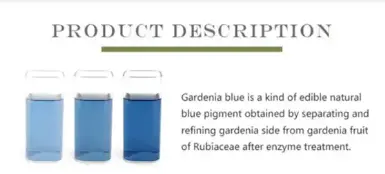Gardenia blue powder, also known as gardenia blue pigment or natural blue colorant, is a fascinating natural food coloring derived from the fruit of the Gardenia jasminoides plant. This vibrant blue powder has gained popularity in recent years as a natural alternative to synthetic blue food dyes. In this blog post, we'll explore the process of making gardenia blue powder and answer some common questions about its production and uses.

What are the benefits of using Gardenia Blue Powder in food products?
Gardenia blue powder offers numerous benefits when used as a natural food coloring agent. First and foremost, it provides a beautiful, vibrant blue hue to various food and beverage products without the need for artificial additives. This is particularly appealing to consumers who are increasingly seeking natural and clean label products.
One of the primary advantages of gardenia blue powder is its stability across a wide range of pH levels. Unlike some other natural blue colorants, such as spirulina, gardenia blue maintains its color in both acidic and alkaline environments. This makes it versatile for use in a variety of food applications, including dairy products, confectionery, and beverages.
Additionally, gardenia blue powder is heat-stable, which means it can withstand high temperatures during food processing without losing its color intensity. This characteristic makes it suitable for use in baked goods, candies, and other products that require heating during production.
Another benefit of gardenia blue powder is its water solubility. This property allows for easy incorporation into liquid-based products and ensures even distribution of color throughout the food matrix. The powder can be easily dissolved in water or other aqueous solutions, making it convenient for manufacturers to use in their formulations.
From a health perspective, gardenia blue powder is considered safe for consumption and has been approved for use as a food coloring in various countries, including Japan and parts of Europe. It is derived from a natural source, which appeals to consumers looking for clean label products free from synthetic additives.
Furthermore, gardenia blue powder offers a sustainable alternative to synthetic blue dyes. As it is derived from a plant source, its production has a lower environmental impact compared to the manufacturing of artificial colorants. This aligns with the growing trend of sustainability in the food industry and appeals to environmentally conscious consumers.
Lastly, the use of gardenia blue powder can contribute to the development of innovative and visually appealing food products. Its unique blue color can be combined with other natural colorants to create a wide range of hues, enabling food manufacturers to produce eye-catching and attractive products that stand out on store shelves.
How does the extraction process of Gardenia Blue Powder work?
The extraction process of gardenia blue powder is a fascinating and intricate procedure that involves several steps to isolate and concentrate the blue pigment from the Gardenia jasminoides fruit. This process has been refined over time to maximize the yield and purity of the blue colorant.
The first step in the extraction process begins with the harvesting of ripe Gardenia jasminoides fruits. These fruits are carefully selected to ensure they contain the highest concentration of the precursor compounds needed for blue pigment formation. Once harvested, the fruits are typically washed and prepared for extraction.
The next stage involves the extraction of geniposide, a key compound found in the gardenia fruit. This is usually done through a solvent extraction process, where the fruits are mixed with a suitable solvent such as ethanol or water. The mixture is then agitated and heated to facilitate the extraction of geniposide from the plant material.
After the initial extraction, the solution undergoes a filtration process to remove any solid plant material. The resulting liquid extract is then concentrated through evaporation or other methods to increase the concentration of geniposide.
The crucial step in the process is the conversion of geniposide into the blue pigment. This is typically achieved through an enzymatic reaction. The concentrated geniposide extract is combined with specific enzymes, often β-glucosidase, which catalyze the hydrolysis of geniposide into genipin. Genipin is the compound responsible for the blue color formation.
Following the enzymatic reaction, the solution undergoes a series of purification steps. These may include additional filtration, centrifugation, or chromatography techniques to isolate and concentrate the blue pigment. The goal is to remove any remaining impurities and achieve a high-purity blue colorant.
Once the blue pigment is isolated, it is typically dried to form a powder. This can be done through spray drying, freeze-drying, or other suitable drying techniques. The choice of drying method can affect the final properties of the powder, such as its solubility and color intensity.
Throughout the extraction and processing stages, careful control of parameters such as temperature, pH, and reaction time is crucial to maximize the yield and quality of the blue pigment. The entire process is often conducted under controlled conditions to ensure consistency and quality of the final product.
It's worth noting that variations of this extraction process exist, and some manufacturers may employ proprietary techniques to optimize their production of gardenia blue powder. Ongoing research continues to explore ways to improve the efficiency and sustainability of the extraction process.
Can Gardenia Blue Powder be used as a natural alternative to synthetic food dyes?
Gardenia blue powder has emerged as a promising natural alternative to synthetic blue food dyes, addressing the growing consumer demand for clean label products. As more people become conscious of the ingredients in their food, there has been a shift away from artificial additives, including synthetic food colorants.
One of the main advantages of gardenia blue powder as a natural alternative is its ability to provide a vibrant blue color without the use of artificial ingredients. Synthetic blue food dyes, such as Brilliant Blue FCF (FD&C Blue No. 1) and Indigotine (FD&C Blue No. 2), have been widely used in the food industry for decades. However, concerns about potential health effects and consumer preferences for natural ingredients have led to increased interest in alternatives like gardenia blue powder.
In terms of performance, gardenia blue powder offers several advantages that make it suitable as a replacement for synthetic blue dyes. As mentioned earlier, it exhibits good stability across a wide pH range and is heat-stable, allowing it to maintain its color in various food applications and processing conditions. These properties are crucial for ensuring that the blue color remains consistent and appealing in the final product.
Furthermore, gardenia blue powder is water-soluble, making it easy to incorporate into a wide range of food and beverage formulations. This characteristic is similar to many synthetic dyes, allowing for a relatively straightforward substitution in existing recipes. Food manufacturers can often use gardenia blue powder as a drop-in replacement without significant changes to their production processes.
Another advantage of gardenia blue powder is its versatility in color mixing. When combined with other natural colorants, it can produce a wide spectrum of colors, including various shades of green, purple, and even black. This flexibility allows food manufacturers to create visually appealing products using entirely natural color sources.
However, it's important to note that while gardenia blue powder is an excellent natural alternative, it may not be a perfect one-to-one replacement for synthetic blue dyes in all applications. Factors such as color intensity, stability in certain food matrices, and cost considerations may need to be taken into account when reformulating products.
In terms of regulatory status, gardenia blue powder has been approved for use as a food coloring in several countries, including Japan and parts of Europe. In the United States, while it is not currently approved as a food additive by the FDA, it can be used in dietary supplements. As research continues and consumer demand grows, it's possible that regulatory approvals may expand in the future.
The adoption of gardenia blue powder as a natural alternative to synthetic dyes aligns with the broader trend of clean label and natural ingredient use in the food industry. It offers food manufacturers an opportunity to meet consumer demands for more natural products while still delivering visually appealing and innovative food items.
Conclusion
As research and development in natural food colors continue, we can expect to see further improvements in the production and application of gardenia blue powder. This ongoing innovation may lead to even more effective and versatile natural blue colorants, further solidifying the position of gardenia blue powder as a viable alternative to synthetic food dyes.
If you are also interested in this product and want to know more product details, or want to know about other related products, please feel free to contact lea_slsbio@163.com,WhatsApp+86 13193326505.

References
1. Pina, F., Melo, M. J., Laia, C. A., Parola, A. J., & Lima, J. C. (2012). Chemistry and applications of flavylium compounds: a handful of colours. Chemical Society Reviews, 41(2), 869-908.
2. He, J., & Giusti, M. M. (2010). Anthocyanins: natural colorants with health-promoting properties. Annual review of food science and technology, 1, 163-187.
3. Lakshmi, C. G. (2014). Food coloring: the natural way. Research Journal of Chemical Sciences, 4(2), 87-96.
4. Martins, N., Roriz, C. L., Morales, P., Barros, L., & Ferreira, I. C. (2016). Food colorants: Challenges, opportunities and current desires of agro-industries to ensure consumer expectations and regulatory practices. Trends in Food Science & Technology, 52, 1-15.
5. Sigurdson, G. T., Tang, P., & Giusti, M. M. (2017). Natural colorants: Food colorants from natural sources. Annual review of food science and technology, 8, 261-280.
6. Carocho, M., Morales, P., & Ferreira, I. C. (2015). Natural food additives: Quo vadis?. Trends in Food Science & Technology, 45(2), 284-295.

